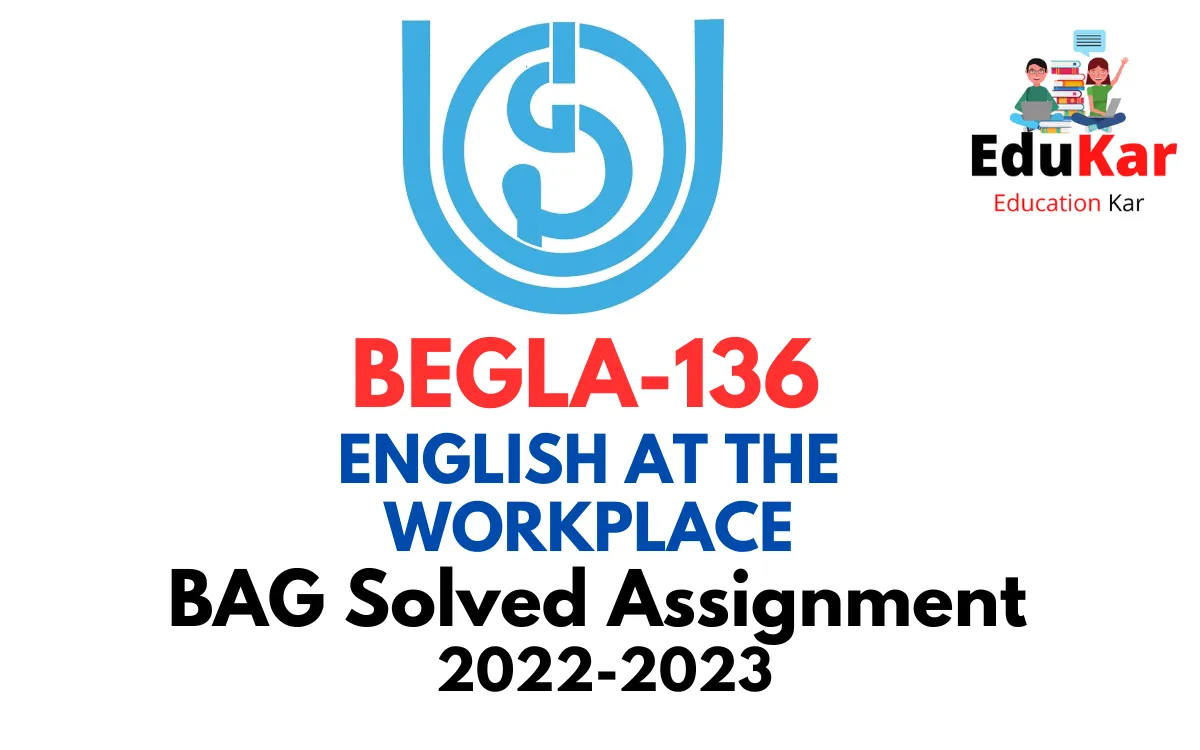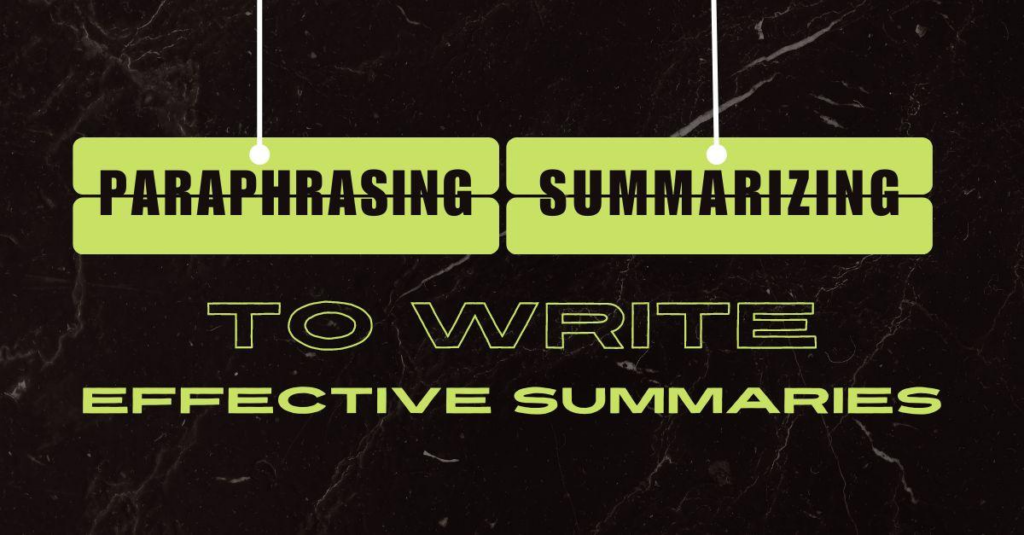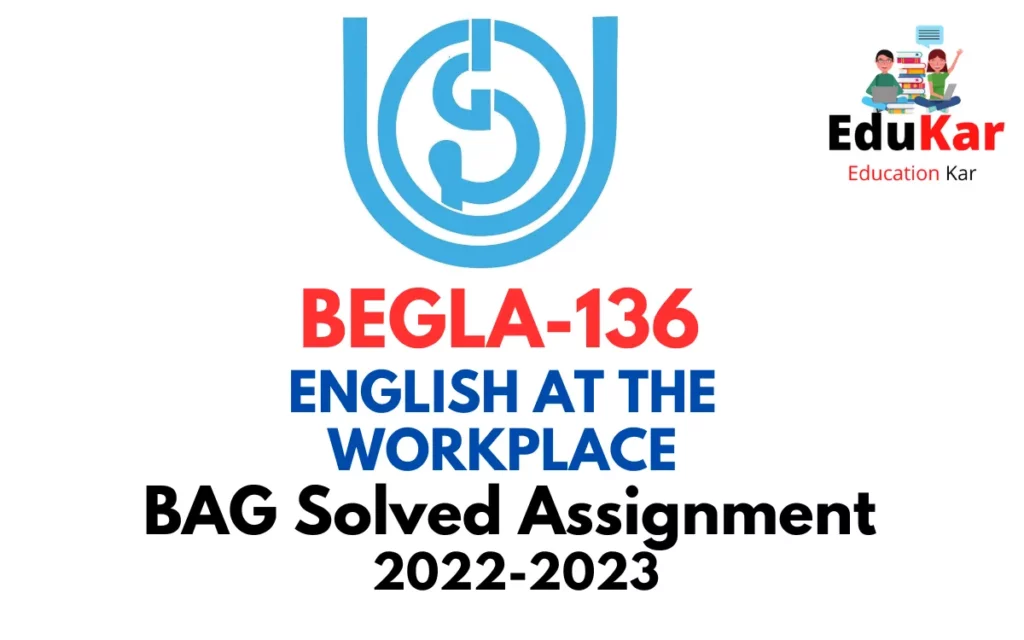
| Title | BEGLA 136: IGNOU BAG Solved Assignment 2022-2023 |
| University | IGNOU |
| Degree | Bachelor Degree Programme |
| Course Code | BEGLA 136 |
| Course Name | ENGLISH AT THE WORKPLACE |
| Programme Name | Bachelor of Arts (General) |
| Programme Code | BAG |
| Total Marks | 100 |
| Year | 2022-2023 |
| Language | English |
| Assignment Code | BAG/2022-2023 |
| Assignment PDF | Click Here |
| Last Date for Submission of Assignment: | For June Examination: 31st March For December Examination: 30th September |
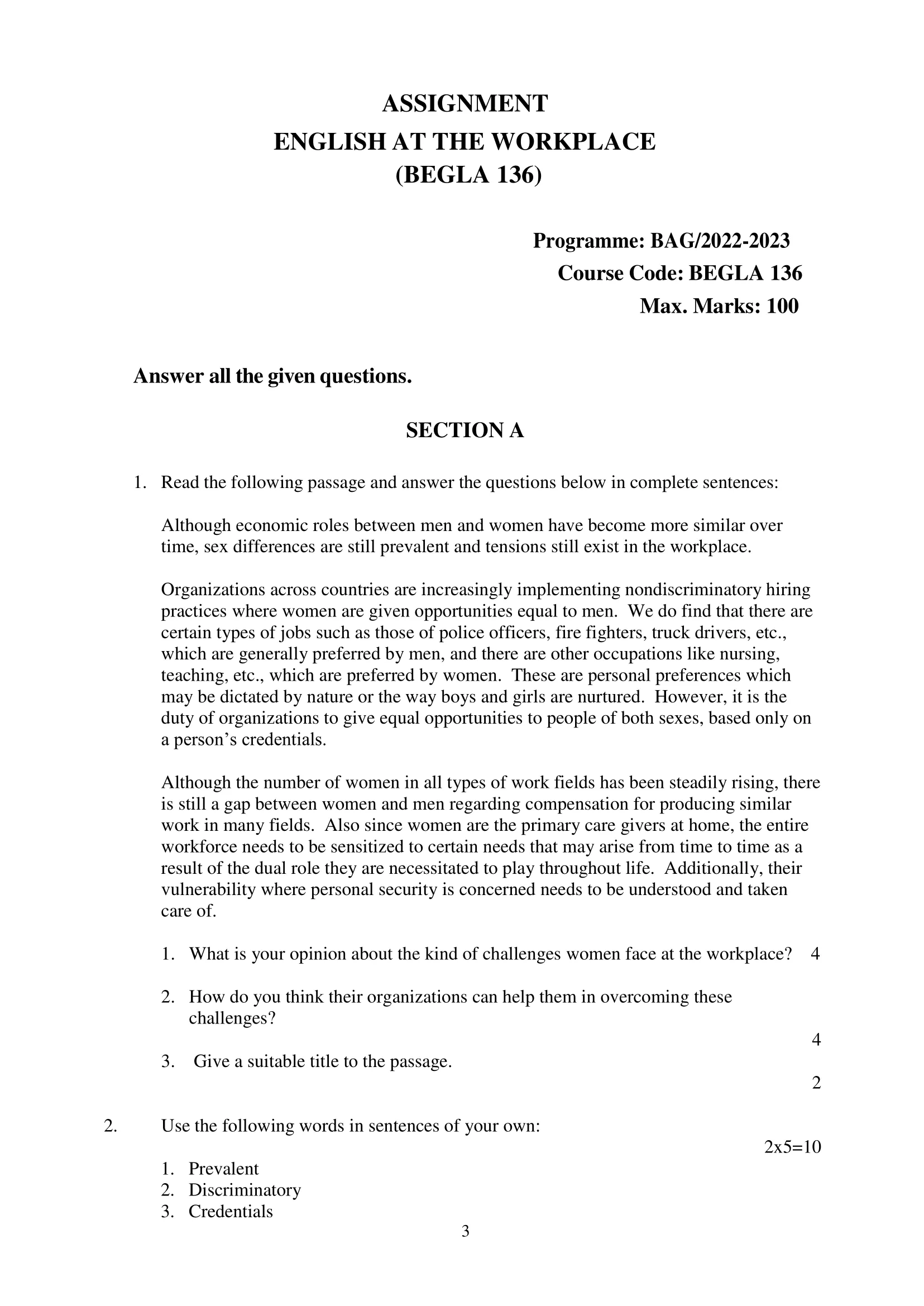
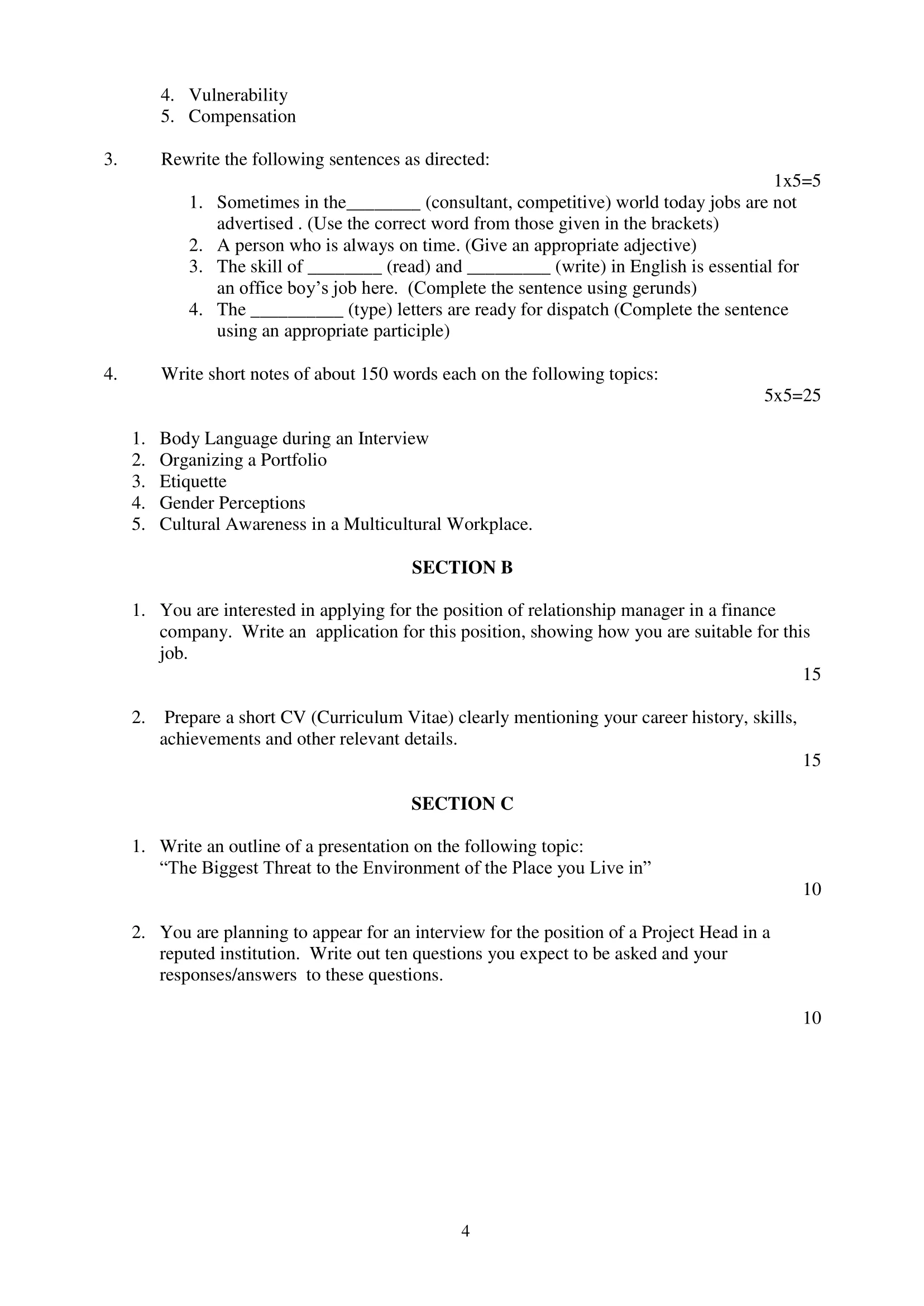
SECTION A
Read the following passage and answer the questions below in complete sentences: Although economic roles between men and women have become more similar over time, sex differences are still prevalent and tensions still exist in the workplace. Organizations across countries are increasingly implementing nondiscriminatory hiring practices where women are given opportunities equal to men. We do find that there are certain types of jobs such as those of police officers, fire fighters, truck drivers, etc., which are generally preferred by men, and there are other occupations like nursing, teaching, etc., which are preferred by women. These are personal preferences which may be dictated by nature or the way boys and girls are nurtured. However, it is the duty of organizations to give equal opportunities to people of both sexes, based only on a person’s credentials.
Although the number of women in all types of work fields has been steadily rising, there is still a gap between women and men regarding compensation for producing similar work in many fields. Also since women are the primary care givers at home, the entire workforce needs to be sensitized to certain needs that may arise from time to time as a result of the dual role they are necessitated to play throughout life. Additionally, their vulnerability where personal security is concerned needs to be understood and taken care of.
1. What is your opinion about the kind of challenges women face at the workplace?
Ans: 1. Sexual Harassment: Workplace sexism and harassment have become even more evident in recent years, with women plucking up the courage to share their horrific experiences. With the #MeToo movement exposing just how widespread sexual voilence, abuse and harassement are in professional environments, and beyond.
2. Pregnancy discrimination: Many working are faced with a major dilemma when it comes to starting a family. Pregnancy discrimination occurs when a woman is treated unfairly due to pregnancy, childbirth or a medical condition related to their pregnancy.
3. Gender pay gap: The gender pay gap is something that’s widely discussed in today’s working world. While some may try to dismiss this issue as a myth, the numbers and figures prove this claim to be false.
2. How do you think their organizations can help them in overcoming these
challenges?
Ans: While acknowledging the contribution of others is an important facet of leadership, acknowledging your own contribution is equally as important. The truth is women face challenges in the workplace all the time. And, some of those challenges are uniquely faced by women simply because of their gender. This is a travesty, of that there is little doubt. There are many ways to tackle this problem.
3. Give a suitable title to the passage.
Ans: Women at the workplace.
Use the following words in sentences of your own:
1. Prevalent
Ans: 1. In many parts of the world, malaria is still a prevalent disease.
2. The use of social media is prevalent among teenagers these days.
3. Due to the prevalent drought conditions, farmers are facing significant losses this year.
4. Obesity is becoming more prevalent in developed countries due to changes in lifestyle and diet.
5. The prevalent attitude towards mental health is changing, and people are becoming more accepting and supportive.
2. Discriminatory
Ans: 1. It’s not right to make discriminatory comments about someone’s race, gender, or sexuality.
2. The company’s hiring practices were found to be discriminatory towards older candidates.
The discriminatory policies of the government have been met with widespread protests.
3. Discriminatory behavior can have a severe impact on a person’s mental health and well-being.
4. The school’s dress code was criticized for being discriminatory towards students who wear religious clothing.
3. Credentials
Ans: 1. In order to apply for this job, you will need to provide your educational credentials.
2. The doctor’s credentials were impressive, and patients trusted his expertise.
3. It’s important to verify the credentials of any person you hire for a sensitive position.
4. The journalist’s credentials were questioned after she published an inaccurate article.
5. The conference required all attendees to wear badges displaying their name and credentials.
4. Vulnerability
Ans: 1. The children living in poverty are particularly vulnerable to illness and malnutrition.
2. Sharing personal stories can be a sign of vulnerability, but it can also help to build connections with others.
3. Cybersecurity is an important issue as it can leave businesses vulnerable to data breaches.
4. Many people find it difficult to express vulnerability because they fear being judged or rejected.
5. The earthquake left thousands of people vulnerable and in need of immediate assistance.
5. Compensation
Ans: 1. The company offers competitive compensation packages to attract top talent.
2. The victims of the accident were awarded compensation for their injuries and lost wages.
3. Some companies offer their employees additional compensation in the form of stock options or bonuses.
4. The artist received no compensation for the use of their work in the advertisement.
5. The compensation for this job includes a salary, health benefits, and paid time off.
Rewrite the following sentences as directed:
1. Sometimes in the________ (consultant, competitive) world today jobs are not advertised . (Use the correct word from those given in the brackets)
Ans: Sometimes in the competitive world today jobs are not advertised.
2. A person who is always on time. (Give an appropriate adjective)
Ans: Punctual.
3. The skill of (read) and _ (write) in English is essential for
an office boy’s job here. (Complete the sentence using gerunds)
Ans: The skill of reading and writing in English is essential for an office boy’s job here.
4. The __ (type) letters are ready for dispatch (Complete the sentence
using an appropriate participle)
Ans: The typed letters are ready for dispatch.
Write short notes of about 150 words each on the following topics:
1. Body Language during an Interview
Ans: Body language can play a crucial role during a job interview. It is the nonverbal cues that you send that can communicate more about you than your words. When you walk into an interview room, remember to greet the interviewer with a firm handshake, make eye contact and smile. It conveys your confidence and enthusiasm. Sitting upright, leaning slightly forward, and maintaining eye contact throughout the interview demonstrate your interest and attentiveness.
Avoid slouching, crossing your arms, or fidgeting with your hands or feet. It can suggest a lack of confidence, boredom or disinterest. Use appropriate hand gestures to emphasize your points, but avoid excessive movements that can be distracting. Mirroring the interviewer’s body language can help build a rapport and establish a connection. However, be cautious not to copy them too obviously.
Your facial expressions can reveal your emotions and attitude. Maintaining a positive, friendly expression conveys a welcoming attitude. However, avoid smirking, rolling your eyes, or frowning, which can indicate arrogance or disrespect.
2. Organizing a Portfolio
Ans: Organizing a portfolio is an important task for students, job seekers, and professionals. It is a collection of your work samples, achievements, and credentials that demonstrate your skills and experience. Here are some steps to organize a portfolio effectively:
- Determine the purpose and audience: Decide why you need a portfolio and who will be viewing it. A portfolio for a job application will differ from a portfolio for a college admission application.
- Select the right format: Choose a format that aligns with your purpose and showcases your work effectively. A digital portfolio can be shared easily, while a physical portfolio can provide a more tactile experience.
- Collect and curate your work samples: Gather your best work samples that demonstrate your skills and accomplishments. Choose work that aligns with your goals and showcases your abilities.
- Organize your portfolio: Arrange your work samples in a logical sequence. You can organize them chronologically, by subject or theme, or by relevance to the position you’re applying for.
- Include supporting materials: Add supporting materials such as certificates, letters of recommendation, and academic transcripts that demonstrate your achievements and credentials.
- Review and update regularly: Review and update your portfolio regularly to ensure it remains relevant and up-to-date. Remove any outdated or irrelevant materials and add new achievements and work samples as they become available.
3. Etiquette
Ans: Etiquette refers to a set of social norms and conventions that guide how we behave in different situations. It includes rules of behavior for social, professional, and cultural settings. Here are some key aspects of etiquette:
- Respect: Show respect to others by using proper language, listening attentively, and acknowledging their opinions and feelings. Respectful behavior shows that you value other people and their contributions.
- Punctuality: Being on time shows that you respect other people’s time and that you are reliable. Plan to arrive a few minutes early to give yourself time to settle in and prepare for the situation.
- Appearance: Dress appropriately for the occasion. Your appearance sends a message about your attitude and how seriously you take the situation.
- Communication: Use appropriate language and tone of voice. Speak clearly and respectfully to convey your message effectively. Avoid interrupting others and speak at an appropriate volume.
- Table manners: Use proper table manners when eating with others. Follow basic rules such as using utensils correctly, chewing with your mouth closed, and avoiding speaking with your mouth full.
- Thank-you notes: Express your gratitude through thank-you notes when appropriate. A handwritten note shows that you took the time to express your appreciation.
4. Gender Perceptions
Ans: Gender perceptions refer to the ways in which society views and treats individuals based on their gender. These perceptions can be influenced by cultural and societal norms, as well as personal biases and beliefs. Here are some key aspects of gender perceptions:
- Stereotypes: Gender stereotypes are beliefs about the characteristics and behaviors that are associated with a particular gender. These stereotypes can influence how individuals are perceived and treated in society.
- Discrimination: Gender discrimination occurs when individuals are treated unfairly based on their gender. This can include unequal pay, limited job opportunities, and gender-based violence.
- Gender identity: Gender identity refers to an individual’s internal sense of their own gender. Society’s perceptions of gender can impact how individuals view their own gender identity and can contribute to feelings of isolation or discrimination.
- Socialization: Socialization refers to the process by which individuals learn societal norms and expectations. Gender socialization can reinforce traditional gender roles and expectations, which can limit individuals’ opportunities and experiences.
- Intersectionality: Intersectionality refers to the ways in which multiple identities, such as race, class, and sexuality, intersect and impact an individual’s experiences of gender perceptions.
5. Cultural Awareness in a Multicultural Workplace.
Ans: Cultural awareness is an essential aspect of working in a multicultural workplace. It refers to the ability to understand, respect, and appreciate the cultural differences of others. Here are some key aspects of cultural awareness in a multicultural workplace:
- Respect: Show respect for other cultures by being open to learning about different customs, beliefs, and values. Avoid making assumptions or judgments based on stereotypes.
- Communication: Effective communication is critical in a multicultural workplace. Be aware of language barriers and cultural differences in communication styles. Listen actively, and ask questions to ensure mutual understanding.
- Sensitivity: Be sensitive to the needs and feelings of others. Recognize that some individuals may feel uncomfortable or uncertain in new cultural settings.
- Flexibility: Be flexible and adaptable to different cultural norms and practices. Be willing to compromise and find common ground.
- Education: Educate yourself about different cultures through reading, attending workshops or cultural events, and engaging in cultural exchange programs.
- Inclusion: Promote inclusion by actively seeking out diverse perspectives and encouraging participation from all team members.
SECTION B
1. You are interested in applying for the position of relationship manager in a finance company. Write an application for this position, showing how you are suitable for this job.
Ans: Dear Hiring Manager,
I am writing to express my interest in the position of Relationship Manager at your finance company. I believe my experience and qualifications make me an ideal candidate for this role.
I have a Bachelor’s degree in Business Administration, and I have worked in the finance industry for the past five years. During this time, I have gained extensive experience in customer service, relationship management, and financial analysis. I have also developed a deep understanding of the financial products and services offered by the industry.
In my previous roles, I have demonstrated my ability to build strong relationships with clients, manage complex financial transactions, and provide exceptional customer service. I have a track record of achieving sales targets and maintaining high levels of customer satisfaction. I am confident that these skills and experiences make me a strong candidate for the role of Relationship Manager.
As a relationship manager, I am committed to understanding the unique needs of each client and providing personalized solutions that meet their financial goals. I have a keen attention to detail, and I am able to manage multiple tasks and deadlines simultaneously. I am a team player who enjoys collaborating with others to achieve common goals.
I am excited about the opportunity to join your finance company and contribute to your success. I look forward to the chance to discuss my qualifications further in an interview.
Thank you for your consideration.
Sincerely, [Your Name]
2. Prepare a short CV (Curriculum Vitae) clearly mentioning your career history, skills, achievements and other relevant details.
Ans: Name: John Smith
Contact Information:
- Email: john@gamil.com
- Phone: (555) 123-4567
Professional Summary: Experienced marketing professional with a proven track record of increasing revenue and improving customer engagement. Skilled in developing and implementing successful marketing strategies, analyzing market trends, and managing cross-functional teams.
Education:
- Bachelor of Business Administration, Marketing – University of California, Los Angeles (UCLA), 2010-2014
- Master of Business Administration – University of Southern California (USC), 2014-2016
Professional Experience:
Marketing Manager – ABC Corporation, Los Angeles, CA (2016-Present)
- Develop and execute strategic marketing plans to drive revenue growth
- Conduct market research to identify opportunities and stay current on industry trends
- Manage cross-functional teams to ensure projects are completed on time and within budget
- Utilize data analytics to measure marketing effectiveness and ROI
- Collaborate with sales team to ensure marketing efforts support sales goals
Marketing Coordinator – XYZ Company, San Francisco, CA (2014-2016)
- Assisted in the development and execution of marketing campaigns
- Coordinated logistics for events and promotional activities
- Conducted research on competitors and market trends
- Managed social media accounts and created content for various channels
Skills:
- Strategic planning and execution
- Market research and analysis
- Project management
- Cross-functional team management
- Data analytics and reporting
- Social media management and content creation
Achievements:
- Led a successful campaign that resulted in a 20% increase in sales revenue
- Developed and implemented a new social media strategy that led to a 50% increase in engagement
- Received recognition from company leadership for outstanding performance and contributions to the team
SECTION C
1. Write an outline of a presentation on the following topic: “The Biggest Threat to the Environment of the Place you Live in”
Ans: I. Introduction
- Briefly introduce the topic of environmental threats in the place you live in.
- Highlight the importance of addressing this issue.
II. Identifying the Biggest Threats
- Explain the process of identifying the biggest threats to the environment.
- Discuss some of the common threats to the environment in the place you live in.
- Focus on the biggest threat and provide relevant statistics and data to support your claims.
III. Causes of the Biggest Threat
- Identify the causes of the biggest environmental threat.
- Explain how these causes are contributing to the threat.
- Provide examples and case studies to illustrate your points.
IV. Impact of the Biggest Threat
- Discuss the impact of the biggest environmental threat on the environment.
- Explain the consequences of not addressing this threat.
V. Solutions to Address the Threat
- Discuss possible solutions to address the biggest environmental threat.
- Highlight the importance of individual and collective action.
- Provide practical tips and steps that individuals can take to address the threat.
VI. Conclusion
- Summarize the main points of the presentation.
- Reiterate the importance of addressing environmental threats.
- Encourage individuals to take action and make a positive impact on the environment.
2. You are planning to appear for an interview for the position of a Project Head in a reputed institution. Write out ten questions you expect to be asked and your responses/answers to these questions.
Ans: 1. Can you tell us about your experience managing large-scale projects?
Answer: Yes, I have managed several large-scale projects throughout my career. For example, in my previous role as a project manager at XYZ Corporation, I oversaw a project that involved the development of a new software product for a Fortune 500 company.
2. How do you prioritize tasks and manage competing deadlines?
Answer: I use a combination of tools and techniques to prioritize tasks, including creating a project timeline, delegating tasks to team members, and using project management software. I also make sure to communicate regularly with stakeholders to keep everyone informed of progress and ensure that deadlines are met.
3. How do you ensure effective communication with project team members and stakeholders?
Answer: I believe that communication is key to the success of any project. I make sure to establish clear lines of communication from the outset, including regular check-ins, status updates, and progress reports. I also encourage team members to raise any concerns or issues they may have, and I work to address these as quickly as possible.
4. Can you give an example of a time when you had to adapt to unexpected changes during a project?
Answer: Yes, in a previous project, we encountered unexpected delays due to unforeseen circumstances. To address this, I worked with the team to re-prioritize tasks and adjust our timeline. I also communicated regularly with stakeholders to keep them informed of the situation and to reassure them that we were taking steps to address the issue.
5. How do you motivate and inspire team members to achieve project goals?
Answer: I believe in leading by example and setting a positive tone for the team. I make sure to recognize team members for their contributions and provide them with regular feedback and support. I also encourage collaboration and teamwork, and I make sure that everyone understands the importance of their role in the project’s success.
6. Can you describe your experience with budget management and cost control?
Answer: Yes, I have extensive experience managing project budgets and ensuring that costs are kept under control. I make sure to establish a clear budget from the outset of the project and to monitor costs closely throughout the project lifecycle. I also work closely with stakeholders to ensure that the budget remains on track and that any deviations are addressed quickly.
7. How do you approach risk management in a project?
Answer: I believe that risk management is critical to the success of any project. I work closely with the team to identify potential risks and to develop a plan to mitigate them. I also make sure to communicate regularly with stakeholders to keep them informed of any risks and to provide reassurance that we have a plan in place to address them.
8. How do you approach team building and leadership in a project?
Answer: I believe in building a strong team culture and fostering a sense of ownership and accountability among team members. I work to create an environment where everyone feels comfortable contributing their ideas and where there is a sense of mutual respect and trust. I also make sure to lead by example and to provide clear guidance and support to team members as needed.
9. How do you measure project success and evaluate the effectiveness of your project management approach?
Answer: I use a variety of metrics to measure project success, including on-time delivery, budget adherence, stakeholder satisfaction, and overall quality. I also make sure to conduct regular project reviews and post-project evaluations to identify areas for improvement and to ensure that lessons learned are incorporated into future projects.
10. Can you tell us about a particularly challenging project you managed and how you overcame obstacles?
Answer: Yes, I once managed a project that involved the implementation of a new enterprise resource planning system for a large manufacturing company. The project faced numerous challenges, including resistance from some team members and unforeseen technical
How to Download BEGLA 136 Solved Assignment?
You can download it from the www.edukar.in, they have a big database for all the IGNOU solved assignments.
Is the BEGLA 136 Solved Assignment Free?
Yes this is absolutely free to download the solved assignment from www.edukar.in
What is the last submission date for BEGLA 136 Solved Assignment?
For June Examination: 31st April, For December Examination: 30th October
